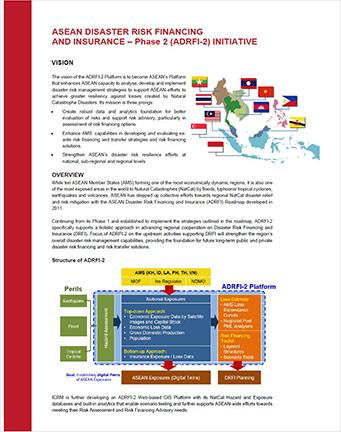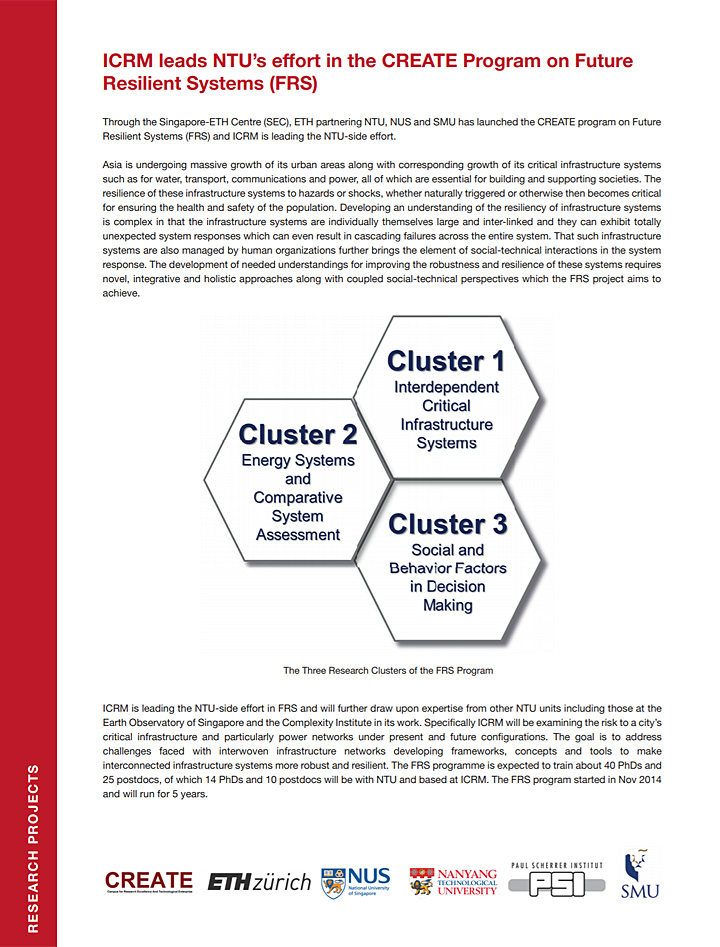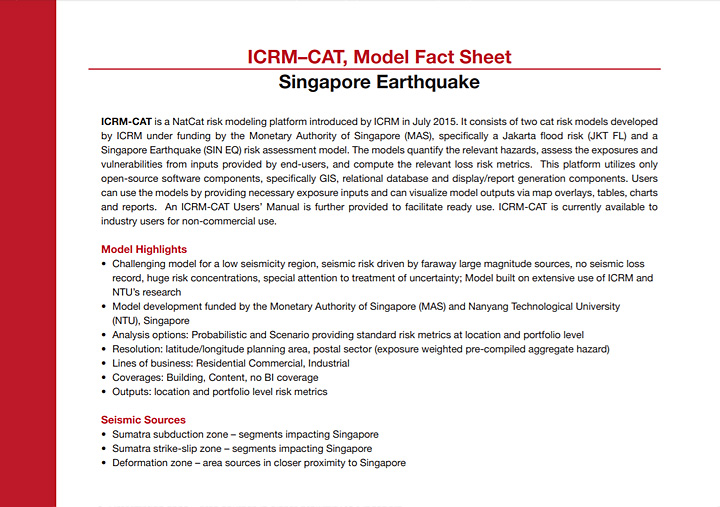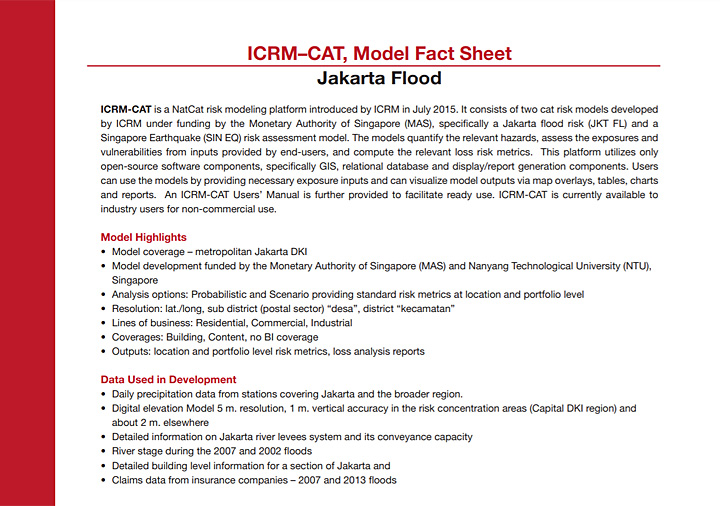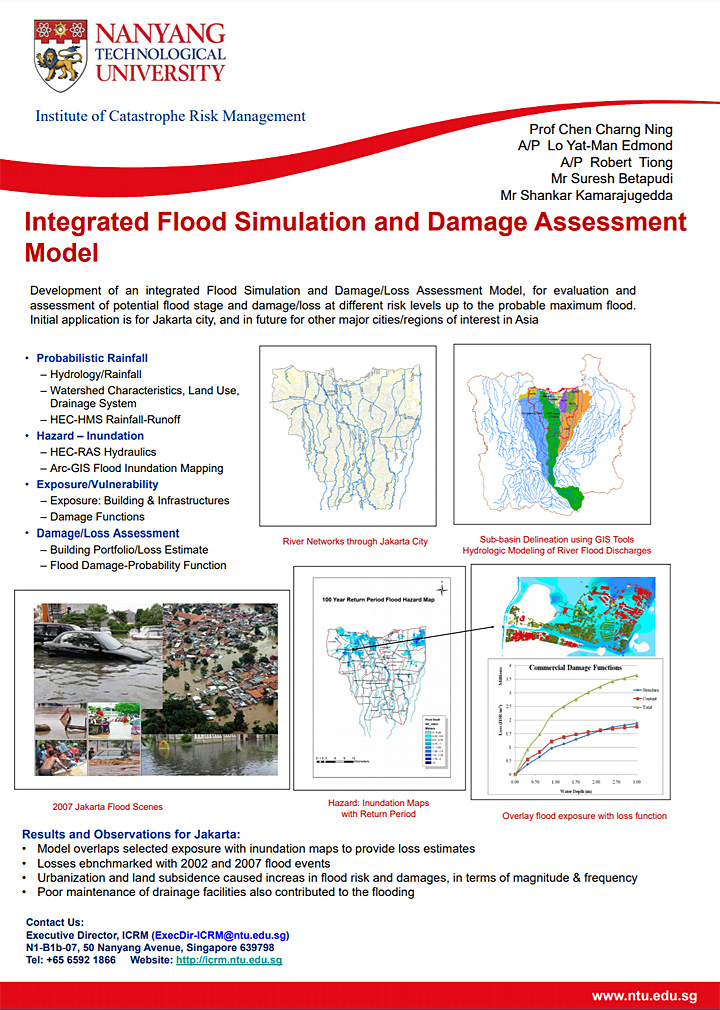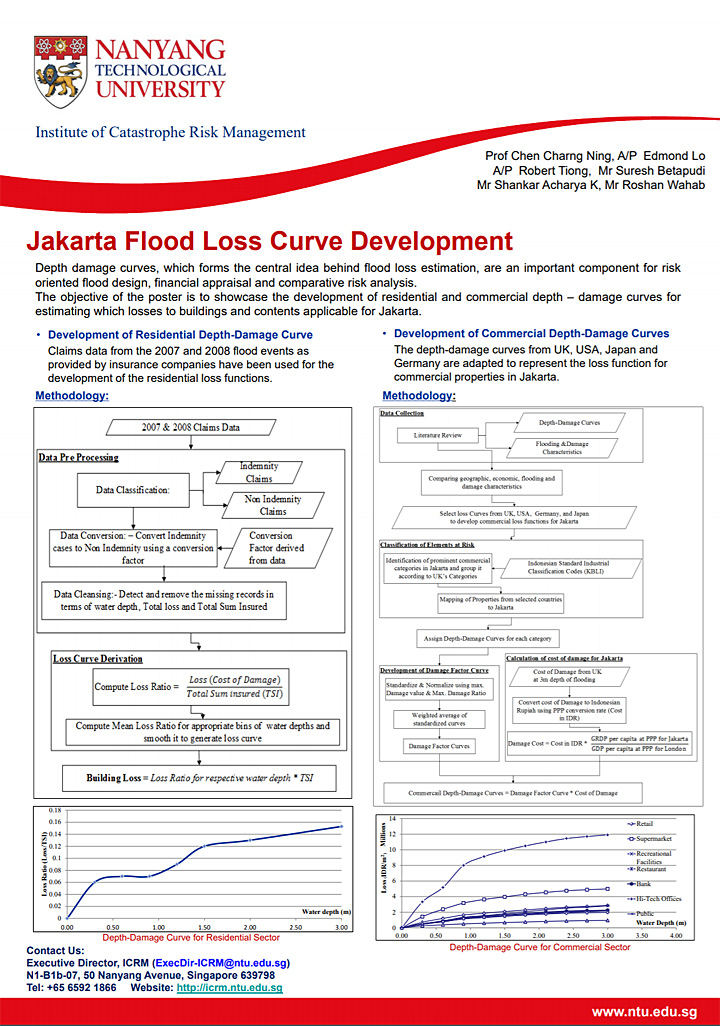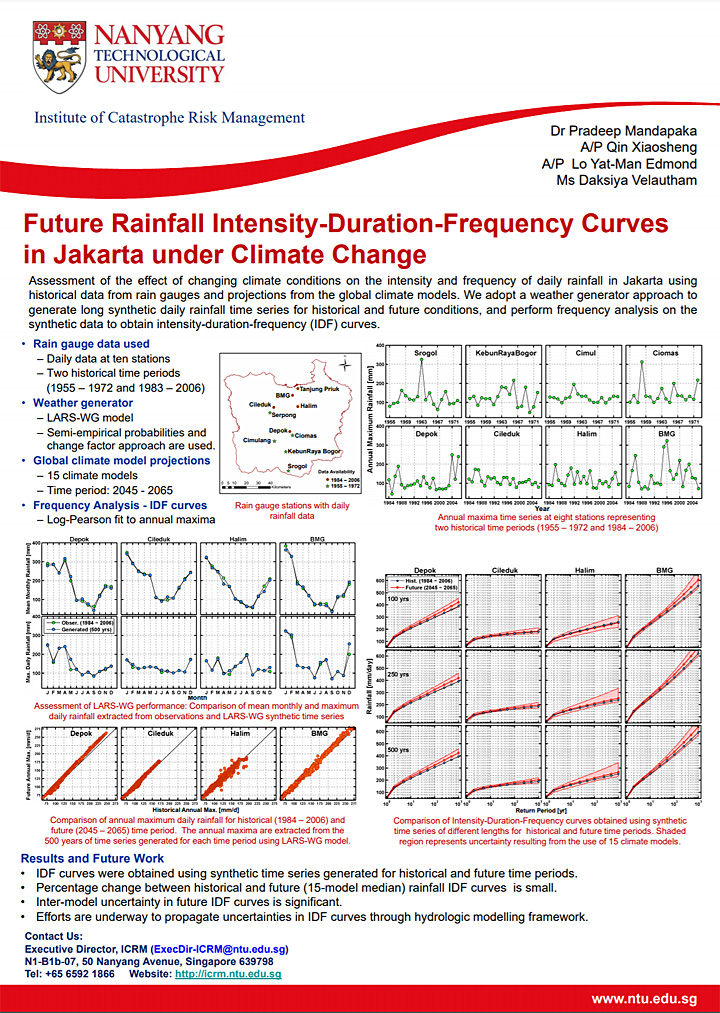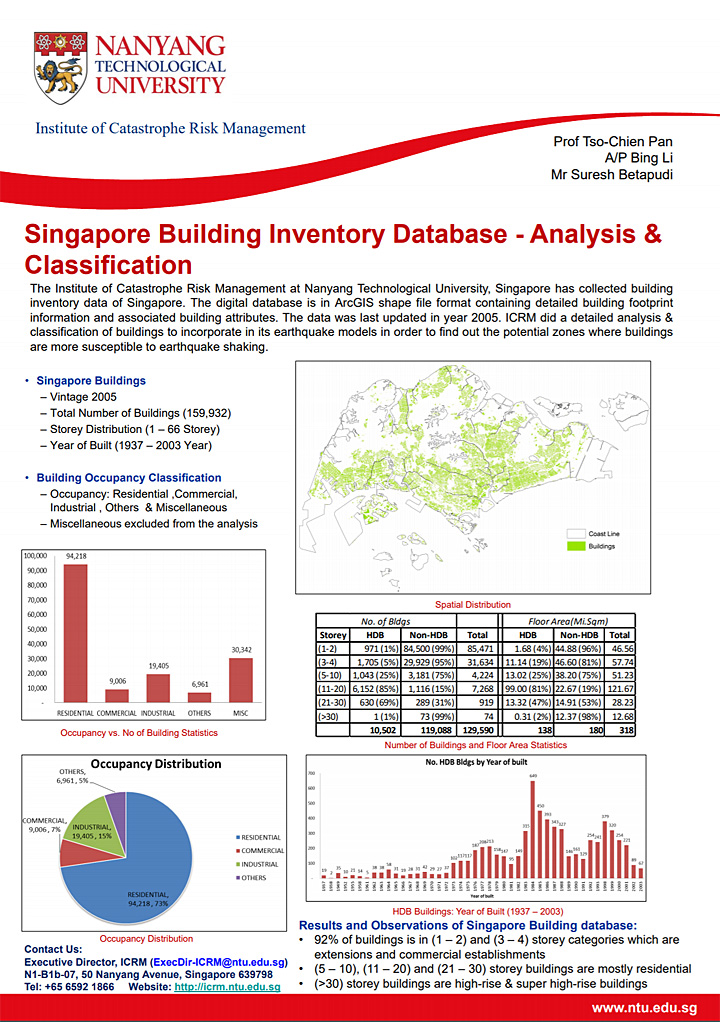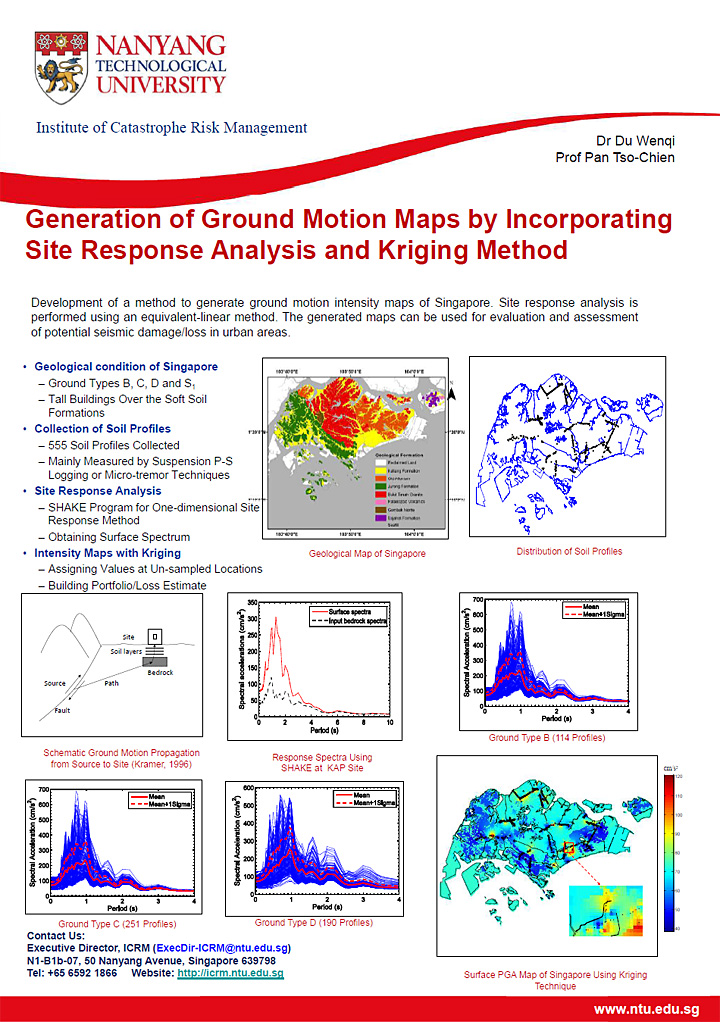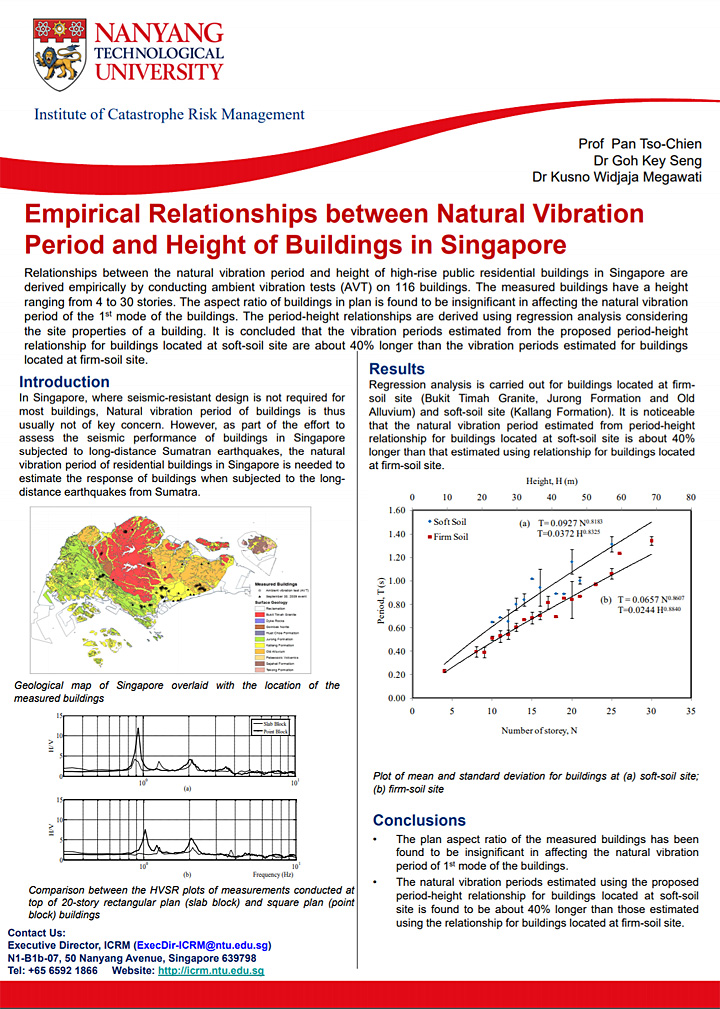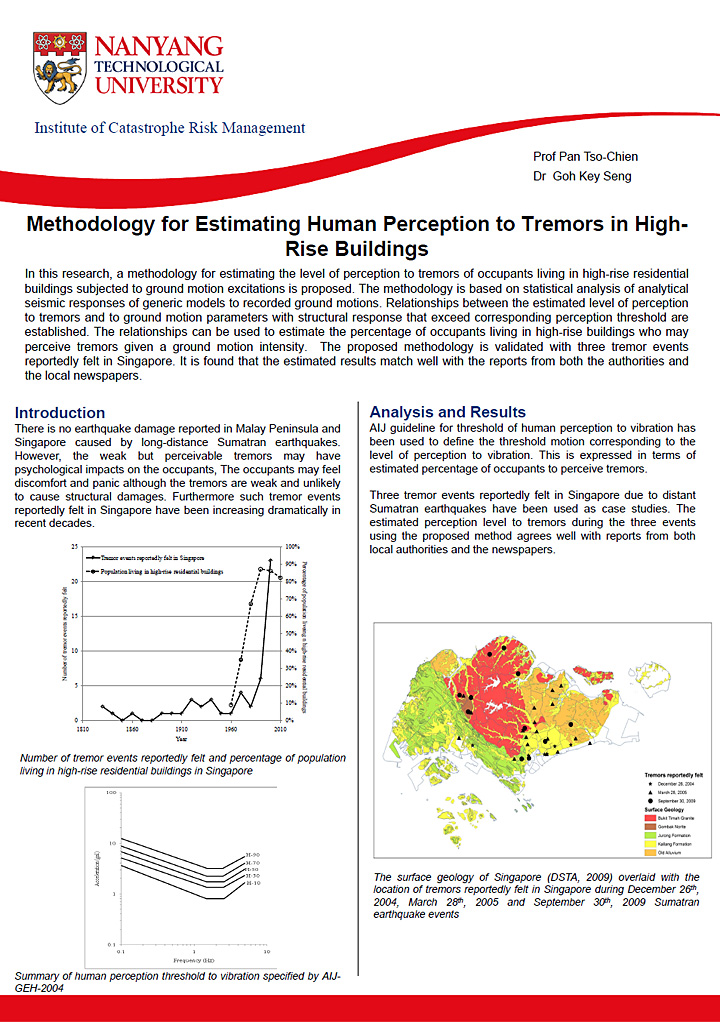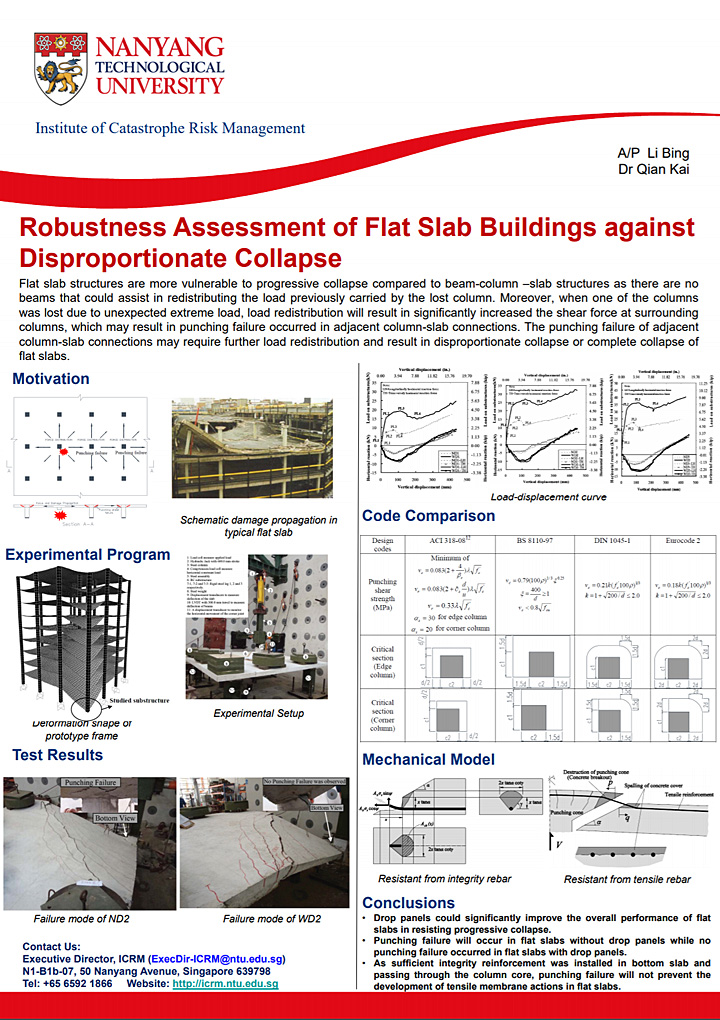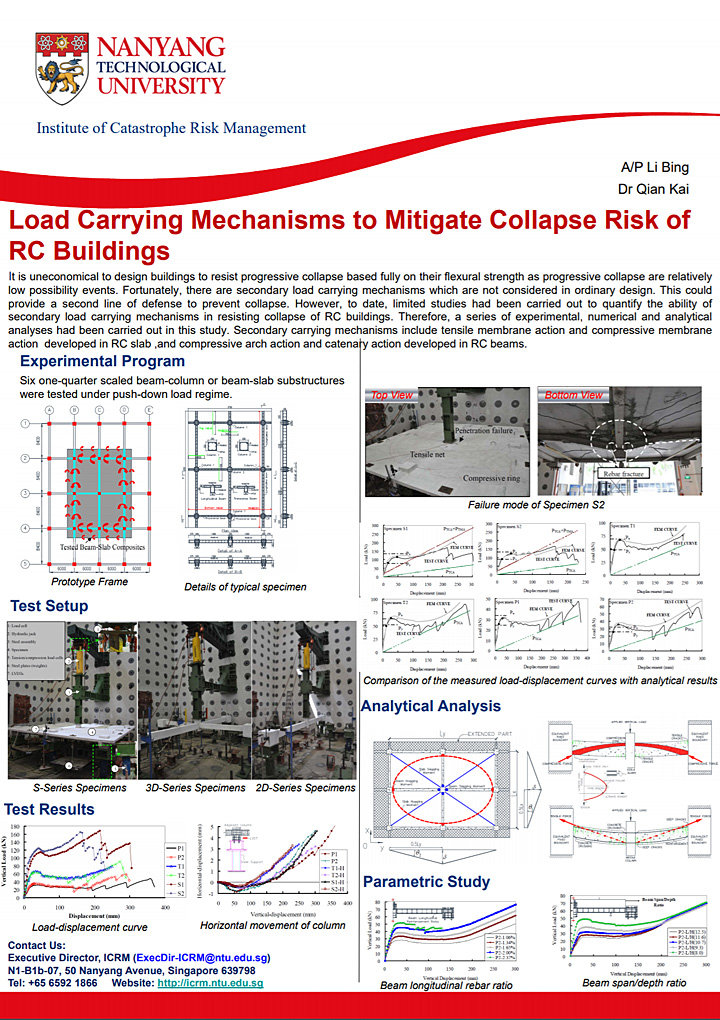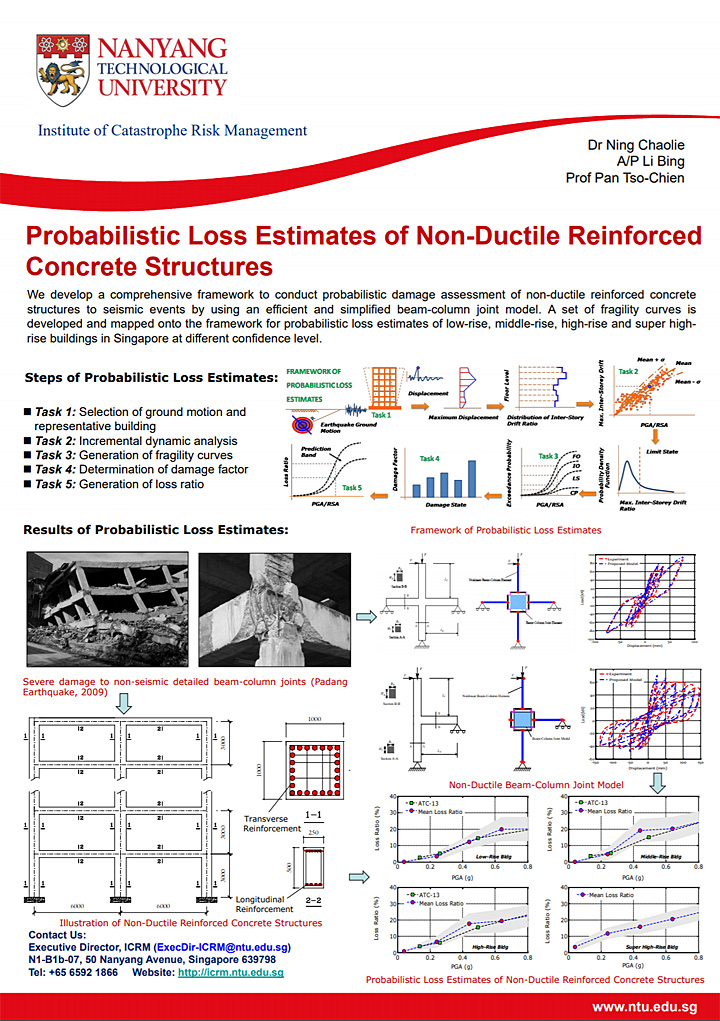Research Projects
ASEAN Disaster Risk Financing and Insurance – Phase 2 (ADRFI-2) Initiative
ASEAN, comprising its 10 ASEAN Member States (AMS), is one of the most economically dynamic regions in the world. However it is one of the most exposed regions to Natural Catastrophes (NatCat) as arising primarily from floods, typhoons (tropical cyclones), earthquakes and volcanoes. ASEAN has in recent years stepped up collective efforts towards regional NatCat disaster relief and risk mitigation with the ASEAN Disaster Risk Financing and Insurance (ADRFI) Roadmap developed in 2011. The ADRFI Phase 2 (ADRFI-2) Programme, as continuing from its Phase 1, has been established to implement the strategies outlined in the roadmap, which specifically support a holistic approach towards viable sovereign risk transfer solutions, and towards regional cooperation on disaster risk financing and risk transfer.
Under ADRFI-2, the Institute of Catastrophe Risk Management (ICRM) at the Nanyang Technological University (NTU) in Singapore and the ASEAN Secretariat have teamed up to execute a multi-year risk financing and reduction program in Aug 2019. This program aims to strengthen the financial resiliency of AMS when NatCat disasters strike, equipping AMS with risk management and risk transfer capabilities that will enable them to better manage the financial burdens caused by disasters. The ultimate goal is to elevate AMS’ capability in Disaster Risk Financing and Insurance (DRFI) to holistically account for the spectrum of risks affecting them, to quantitatively measure the risks, and based on that to develop appropriate risk management and risk transfer strategies.
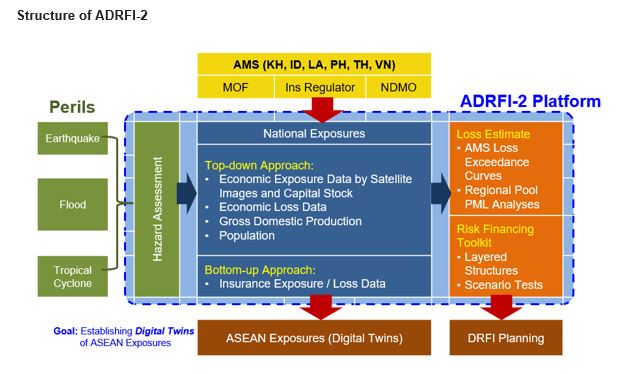
ADRFI’s focus on the upstream activities supporting disaster risk financing will strengthen the ASEAN’s overall disaster risk management capabilities and lead to improved disaster risk resiliency. The ADRFI-2 programme is founded on three pillars, Risk Assessment, Risk Financing Advisory and Capacity Building with ICRM spearheading the first two pillars. ICRM is further developing an ADRFI-2 Web-based GIS Platform with its NatCat Hazard and Exposure databases and built-in analytics that that enable scenario testing and further supports ASEAN-wide efforts towards meeting their Risk Assessment and Risk Financing Advisory needs.
For enquiries, please contact:
Director, ICRM
Email: [email protected]
Tel: +65 - 6592 1872
NatCatDAX Program
Natural catastrophes (Nat Cat) disproportionally affect Asia in terms of economic losses and casualties, which in large part could be attributed to: (i) the low insurance penetration, (ii) low catastrophe (cat) risk awareness in the region, and (iii) in comparison with Western countries (e.g. Europe, US) lack of effective risk transfer mechanisms of the cat risk.
However data necessary for catastrophe risk quantification in Asia and in SE Asia, is in general poor in terms of availability, accessibility and quality. ICRM is leading the establishment of a Natural Catastrophe Data and Analytics Exchange (NatCatDAX) Alliance as an association of industry interest group to address the above data and modelling gaps, through an industry-led catastrophe data and analytics platform for Asia Pacific and starting with SE Asia.
Natural Catastrophe Data Analytics Exchange factsheet
For enquiries, please contact:
Executive Director, ICRM
Email: [email protected]
Tel: +65 - 6592 1872
Fax: +65 - 6794 8231
Future Resilient Systems (FRS) Program
Asia is undergoing massive urban growth along with corresponding growth of its critical infrastructure systems e.g., transport and power. The resilience of these systems to hazards or shocks, whether naturally triggered or otherwise becomes critical for ensuring the safety of the population.
Developing an understanding of the resiliency of these systems is complex in that the infrastructure systems are individually themselves large and inter-linked and can exhibit unexpected system responses or even cascading failures. That such infrastructure systems are also managed by human organizations further brings the element of social-technical interactions into the system response.
The development of needed understandings for improving the robustness and resilience of these systems requires novel, integrative and holistic approaches along with coupled social-technical perspectives which the FRS program aims to achieve. Through the Singapore-ETH Centre (SEC), ETH partnering NTU, NUS and SMU has established the CREATE program on Future Resilient Systems (FRS) and ICRM is leading the NTU-side effort.
ICRM-CAT Platform
ICRM-CAT is a Natural (Nat) Catastrophe (Cat) Risk Modeling platform developed by ICRM under funding from the Monetary Authority of Singapore (MAS). The platform deploys two ICRM models namely: Singapore Earthquake (SIN EQ) and Jakarta DKI (Daerah Khusus Ibukota or Special Capital Areas) Flood (JKT FL) models. Being an academic institution ICRM aimed for ICRM-CAT to incorporate state-of-the art risk modeling and quantification methodologies.
Secondly, ICRM deployed the SIN EQ and JKT FL models on a platform that could be readily used by the insurance industry in Singapore. As such ICRM-CAT generates standard financial metrics for loss assessment so as to facilitate follow-on industry evaluation and testing, and later adoption.
Macro-level Seismic Loss Estimate of Megacities
There is increasing trend of urbanization around the world. The complexity of understanding and then managing megacity risks is immense. Nowadays more and more megacities are located in or close to natural hazard-prone regions.
A macro-level seismic assessment model for megacity is proposed to estimate the potential seismic loss in current year and in the future. Initial application is to Shanghai city, and in future to other major cities/regions of interest in Asia.
Integrated Flood Simulation and Damage Assessment Model
Development of an integrated Flood Simulation and Damage/Loss Assessment Model, for evaluation and assessment of potential flood stage and damage/loss at different risk levels up to the probable maximum flood. Initial application is for Jakarta city, and in future for other major cities/regions of interest in Asia.
Jakarta Flood Loss Curve Development
Depth damage curves, which forms the central idea behind flood loss estimation, are an important component for risk oriented flood design, financial appraisal and comparative risk analysis.
The objective of the poster is to showcase the development of residential and commercial depth – damage curves for estimating which losses to buildings and contents applicable for Jakarta.
Future Rainfall Intensity-Duration-Frequency Curves in Jakarta under Climate Change
Assessment of the effect of changing climate conditions on the intensity and frequency of daily rainfall in Jakarta using historical data from rain gauges and projections from the global climate models.
We adopt a weather generator approach to generate long synthetic daily rainfall time series for historical and future conditions, and perform frequency analysis on the synthetic data to obtain intensity-duration-frequency (IDF) curves.
Multi-objective Stochastic Optimization for Flood Risk Management with Integrated Stochastic Surrogate and Genetic Algorithms
A multi-objective stochastic optimization model is developed to assist decision making problem for urban flood risk management under uncertainty. An evolutionary-based multi-objective optimization technique integrated with advanced stochastic surrogate modeling and advanced stochastic simulation algorithms is used to find the non-dominated flood risk management solutions that optimize conflicting objectives simultaneously. The proposed method is applied to Chester Creek Watershed, PA, and in future will be applied to other major cities/regions in Asia.
Seismicity Analysis for the Sumatra Region
A seismicity analysis for the Sumatra region is carried out by considering the two regional tectonic structures of Sumatra (Sumatra subduction and Sumatra strike-slip fault) and the stable Sunda plate.
For the present study, the search spatial window for earthquake events are from and within the coordinates 7.5°S to 10°N and 90°E to 112°E from different available catalogue sources (BGS, ISC-GEM, ARUP, GCMT, ISC, USGS and ANSS). The temporal end date for catalogue is 30 June 2013 inclusive.
Singapore Building Inventory Database - Analysis & Classification
The Institute of Catastrophe Risk Management at Nanyang Technological University, Singapore has collected building inventory data of Singapore. The digital database is in ArcGIS shape file format containing detailed building footprint information and associated building attributes.
The data was last updated in year 2005. ICRM did a detailed analysis & classification of buildings to incorporate in its earthquake models in order to find out the potential zones where buildings are more susceptible to earthquake shaking.
Generation of Ground Motion Maps by Incorporating Site Response Analysis and Kriging Method
Development of a method to generate ground motion intensity maps of Singapore. Site response analysis is performed using an equivalent-linear method. The generated maps can be used for evaluation and assessment of potential seismic damage/loss in urban areas.
Empirical Relationships between Natural Vibration Period and Height of Buildings in Singapore
Relationships between the natural vibration period and height of high-rise public residential buildings in Singapore are derived empirically by conducting ambient vibration tests (AVT) on 116 buildings. The measured buildings have a height ranging from 4 to 30 stories. The aspect ratio of buildings in plan is found to be insignificant in affecting the natural vibration period of the 1st mode of the buildings.
The period-height relationships are derived using regression analysis considering the site properties of a building. It is concluded that the vibration periods estimated from the proposed period-height relationship for buildings located at soft-soil site are about 40% longer than the vibration periods estimated for buildings located at firm-soil site.
Methodology for Estimating Human Perception to Tremors in High-Rise Buildings
In this research, a methodology for estimating the level of perception to tremors of occupants living in high-rise residential buildings subjected to ground motion excitations is proposed. The methodology is based on statistical analysis of analytical seismic responses of generic models to recorded ground motions.
Relationships between the estimated level of perception to tremors and to ground motion parameters with structural response that exceed corresponding perception threshold are established. The relationships can be used to estimate the percentage of occupants living in high-rise buildings who may perceive tremors given a ground motion intensity.
The proposed methodology is validated with three tremor events reportedly felt in Singapore. It is found that the estimated results match well with the reports from both the authorities and the local newspapers.
Robustness Assessment of Flat Slab Buildings against Disproportionate Collapse
Flat slab structures are more vulnerable to progressive collapse compared to beam-column –slab structures as there are no beams that could assist in redistributing the load previously carried by the lost column.
Moreover, when one of the columns was lost due to unexpected extreme load, load redistribution will result in significantly increased the shear force at surrounding columns, which may result in punching failure occurred in adjacent column-slab connections.
The punching failure of adjacent column-slab connections may require further load redistribution and result in disproportionate collapse or complete collapse of flat slabs.
Load Carrying Mechanisms to Mitigate Collapse Risk of RC Buildings
It is uneconomical to design buildings to resist progressive collapse based fully on their flexural strength as progressive collapse are relatively low possibility events. Fortunately, there are secondary load carrying mechanisms which are not considered in ordinary design.
This could provide a second line of defense to prevent collapse. However, to date, limited studies had been carried out to quantify the ability of secondary load carrying mechanisms in resisting collapse of RC buildings. Therefore, a series of experimental, numerical and analytical analyses had been carried out in this study.
Secondary carrying mechanisms include tensile membrane action and compressive membrane action developed in RC slab ,and compressive arch action and catenary action developed in RC beams.
Probabilistic Loss Estimates of Non-Ductile Reinforced Concrete Structures
We develop a comprehensive framework to conduct probabilistic damage assessment of non-ductile reinforced concrete structures to seismic events by using an efficient and simplified beam-column joint model.
A set of fragility curves is developed and mapped onto the framework for probabilistic loss estimates of low-rise, middle-rise, high-rise and super high-rise buildings in Singapore at different confidence level.
Others
- Assessment of Urban Flood Resiliency under Present and Future Scenarios
PI : Assoc Prof Lo Yat-Man, Edmond
Co-PIs : Asst. Prof Qin Xiaosheng and Asst. Prof Cheung Sai Hung - Seismic Hazard and Risk of Building Stock within the Kallang Basin, Singapore
A/Prof. Bing Li, Asst/Prof. Kusnowidjaja Megawati - Building instrumentation and structural health monitoring
Dr Zhen Haitao, PI/Supervisor: Asst/Prof. Kusnowidjaja Megawati - Seismic hazard assessment
Dr Avik Samantha, PI/Supervisor: Asst/Prof. Kusnowidjaja Megawati - Seismic Fragility of LRC Frames
Zhang Guanghui, PI/Supervisor: A/Prof. Li Bing - Hysteresis modelling of Beam Column Joints and Shear Walls for Seismic Fragility Assessment
Piyali Sengupta, PI/Supervisor: A/Prof. Li Bing - Seismic Behavior of Reinforced Concrete Walls under Different Directions of Seismic Loading
Zhang Zhong Wen, PI/Supervisor: A/Prof. Li Bing - Seismic Behavior of L and T shape RC columns with Light Transverse Reinforcement
Pham Thanh Phuong, PI/Supervisor: A/Prof. Li Bing - Flood Risk Simulation Model for Jakarta, Indonesia
Prof. Chen CN, A/Prof. Edmond Lo, A/Prof. Robert Tiong, Asst/Prof. Qin XS, Asst/Prof. Cheung SH Joseph,
Dr Shu EB - Statistical Downscaling and Disaggregation of Regional Climate Data
PI/Supervisor: Asst/Prof Qin XS, Asst/Prof Cheung SH - PhD: Climate change impact analysis and hydrologic modeling
Ms. Lu Yan, PI/Supervisor: Asst/Prof. Qin XS - PhD: Tsunami and flood loss assessment
Mr. Shao Zhe, PI/Supervisor: Asst/Prof. Cheung SH, A/Prof. Robert Tiong - Damage and loss assessment of floods
Mr. Roshan Wahab, PI/Supervisor: A/Prof. Robert Tiong - MHA: Development of a GIS-based System for Earthquake Response Monitoring of Buildings
in Singapore
Dr Zheng Haitao, Dr Avik Samanta PI/Supervisor: Prof. Kusnowidjaja Megawati - Planning and management of infrastructure systems phase I: studies on mega projects in Singapore
Ms Zheng Sha, PI/Supervisor: A/Prof. Robert Tiong

